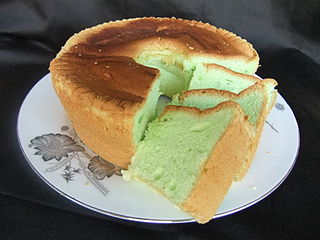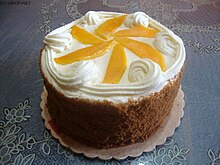
A wedding cake is the traditional cake served at wedding receptions following dinner. In some parts of England, the wedding cake is served at a wedding breakfast; the 'wedding breakfast' does not mean the meal will be held in the morning, but at a time following the ceremony on the same day. In modern Western culture, the cake is usually on display and served to guests at the reception. Traditionally, wedding cakes were made to bring good luck to all guests and the couple. Nowadays, however, they are more of a centerpiece to the wedding and are not always even served to the guests. Some cakes are built with only a single edible tier for the bride and groom to share, but this is rare since the cost difference between fake and real tiers is minimal.

Cheesecake is a dessert made with a soft fresh cheese, eggs, and sugar. It may have a crust or base made from crushed cookies, graham crackers, pastry, or sometimes sponge cake. Cheesecake may be baked or unbaked, and is usually refrigerated.

The ensaïmada is a pastry product from Mallorca, Balearic Islands, Spain. It is a common cuisine eaten in southwestern Europe, Latin America and the Philippines.

A Swiss roll, jelly roll, roll cake, cream roll, roulade or Swiss log is a type of rolled sponge cake filled with whipped cream, jam, icing, or any type of filling. The origins of the term are unclear; in spite of the name "Swiss roll", the cake is believed to have originated elsewhere in Central Europe, possibly Austria or Slovenia. It appears to have been invented in the nineteenth century, along with Battenberg cake, doughnuts, and Victoria sponge. In the U.S., commercial snack-sized versions of the cake are sold with the brand names Ho Hos, Yodels, Swiss Cake Rolls, and others. A type of roll cake called Yule log is traditionally served at Christmas.

Filipino cuisine is composed of the cuisines of more than a hundred distinct ethnolinguistic groups found throughout the Philippine archipelago. A majority of mainstream Filipino dishes that compose Filipino cuisine are from the food traditions of various ethnolinguistic groups and tribes of the archipelago, including the Ilocano, Pangasinan, Kapampangan, Tagalog, Bicolano, Visayan, Chavacano, and Maranao ethnolinguistic groups. The dishes associated with these groups evolved over the centuries from a largely indigenous base shared with maritime Southeast Asia with varied influences from Chinese, Spanish, and American cuisines, in line with the major waves of influence that had enriched the cultures of the archipelago, and adapted using indigenous ingredients to meet local preferences.

Christmas cake is a type of cake, often fruitcake, served at Christmas time in many countries.

Pandan cake is a light, fluffy, green-coloured sponge cake flavoured with the juices of Pandanus amaryllifolius leaves. It is also known as pandan chiffon. The cake is popular in Malaysia, Indonesia, Singapore, Vietnam, Cambodia, Laos, Thailand, Sri Lanka, Hong Kong, China, and also the Netherlands. It is similar to the buko pandan cake of the Philippines, but differs in that it does not use coconut.

An icebox cake is a dairy-based dessert made with cream, fruits, nuts, and wafers and set in the refrigerator. One particularly well-known version used to be printed on the back of boxes of thin and dark Nabisco Famous Chocolate Wafers.

Mamón are traditional Filipino chiffon or sponge cakes, typically baked in distinctive cupcake-like molds. In the Visayas regions, mamón are also known as torta mamón or torta. Variants of mamón include the larger loaf-like version called taisan, the rolled version called pianono, and ladyfingers known as broas. Mamón also has two very different variants that use mostly the same ingredients, the cookie-like mamón tostado and the steamed puto mamón.

Sponge cake is a light cake made with eggs, flour and sugar, sometimes leavened with baking powder. Some sponge cakes do not contain egg yolks, like angel food cake, but most of them do. Sponge cakes, leavened with beaten eggs, originated during the Renaissance, possibly in Spain. The sponge cake is thought to be one of the first non-yeasted cakes, and the earliest attested sponge cake recipe in English is found in a book by the English poet Gervase Markham, The English Huswife, Containing the Inward and Outward Virtues Which Ought to Be in a Complete Woman (1615). Still, the cake was much more like a cracker: thin and crispy. Sponge cakes became the cake recognised today when bakers started using beaten eggs as a rising agent in the mid-18th century. The Victorian creation of baking powder by English food manufacturer Alfred Bird in 1843 allowed the addition of butter to the traditional sponge recipe, resulting in the creation of the Victoria sponge. Cakes are available in many flavours and have many recipes as well. Sponge cakes have become snack cakes via the Twinkie.

Brazo de Mercedes is a traditional Filipino meringue roll with a custard filling typically dusted with powdered sugar. It is a type of pianono.

Sans rival is a Filipino dessert cake made of layers of buttercream, meringue and chopped cashews. Its name means "unrivaled" in French. The cake may be decorated, left plain or garnished with pistachios.

Crema de fruta is a traditional Filipino fruitcake made with layers of sponge cake, sweet custard or whipped cream, gelatin or gulaman (agar), and various preserved or fresh fruits, including mangoes, pineapples, cherries, and strawberries. It is usually served during the Christmas season. It has multiple variations, ranging from changes in the fruits used to the addition of ingredients like jam, sago, condensed milk, and others.

Mango float or crema de mangga is a Filipino icebox cake dessert made with layers of ladyfingers (broas) or graham crackers, whipped cream, condensed milk, and ripe carabao mangoes. It is chilled for a few hours before serving, though it can also be frozen to give it an ice cream-like consistency. It is a modern variant of the traditional Filipino crema de fruta cake. It is also known by various other names like mango refrigerator cake, mango graham float, mango royale, and mango icebox cake, among others. Crema de mangga is another version that additionally uses custard and gulaman (agar) or gelatin, as in the original crema de fruta.

Cassava cake is a traditional Filipino moist cake made from grated cassava, coconut milk, and condensed milk with a custard layer on top. It is a very popular dish in the Philippines, where it is commonly eaten for merienda. It is also served during gatherings and special occasions.

Ube cake is a traditional Filipino chiffon cake or sponge cake made with ube halaya. It is distinctively vividly purple in color, like most dishes made with ube in the Philippines.

Yema cake is a Filipino chiffon cake with a custard filling known as yema. It is generally prepared identically to mamón, with the only difference being that it incorporates yema either as frosting, as filling, or as part of the cake batter. Yema is a custard-like combination of milk and egg yolks. It is also typically garnished with grated cheese.

Buko pandan cake, also known as pandan macapuno cake or coconut pandan cake, is a Filipino chiffon or sponge cake (mamón) flavored with extracts from boiled pandan leaves and frosted with cream with young coconut strips and/or macapuno as toppings or fillings. It is a cake version of the traditional Filipino pairing of buko pandan. It is similar to the pandan cakes in other parts of Southeast Asia, but differ in that it is not served plain. It is always frosted with cream and coconut.

Flan cake, also known as leche flan cake or crème caramel cake, is a Filipino chiffon or sponge cake (mamón) baked with a layer of leche flan on top and drizzled with caramel syrup. It is sometimes known as "custard cake", which confuses it with yema cake. Modern versions of flan cake can be cooked with a variety of added ingredients. An example is the use of ube cake as the base.

Ube cheesecake, also known as purple yam cheesecake, is a Filipino cheesecake made with a base of crushed graham crackers and an upper layer of cream cheese and ube halaya. It can be prepared baked or simply refrigerated. Like other ube desserts in the Philippines, it is characteristically purple in color.






















